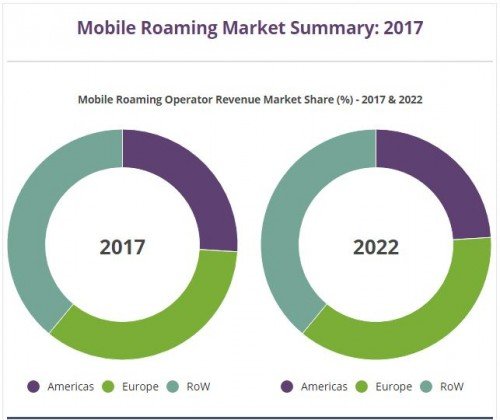 Telecom operator revenues from international mobile data roaming are expected to reach $31 billion in 2022 — growing at 8 percent CAGR — from $21 billion in 2017.
Telecom operator revenues from international mobile data roaming are expected to reach $31 billion in 2022 — growing at 8 percent CAGR — from $21 billion in 2017.
The increase in international mobile data roaming revenue is despite a drop in data revenues by 11 percent in 2017 – including 46 percent decline in West Europe – as a result of operators increasingly offering RLAH (Roam Like at Home) packages around the world, said Juniper Research.
RLAH enables users to use their monthly voice, data, and messaging allowance while roaming without incurring additional charges.
Juniper Research said the launch of unlimited roaming data plans in the US, Europe, and Far East will significantly drive usage by mobile roamers, leading to average data usage exceeding 1GB by the end of 2020.

“There is very limited room for improvement on voice roaming in terms of increasing the scale of revenue. However, with data, alongside the potential to offer customised, contextual roaming bundles and services, the cost per MB is expected to fall significantly in most regions. This will encourage ‘non-data’ roamers to become active roamers,” said Research author Nitin Bhas.
How to enhance revenue
A recent report from Strategy Analytics said mobile operators can drive up profits and deliver improved customer experience if they use LTE upgrades to underpin strong unlimited or zero-rated data offerings.
The report noted examples from telecom markets such as Finland, South Korea, US and China, as well as offerings from Vodafone and Deutsche Telekom. More operators will be launching unlimited data plans supported by LTE-A, LTE-A Pro and unlicensed LTE, including Licensed Assisted Access LTE (LAA) upgrades.
Susan Welsh de Grimaldo, director, Service Provider Strategies at Strategy Analytics, said mobile operators, which are considering unlimited data plans, should implement LTE-A, LTE-A Pro and unlicensed LTE features in their network.
Juniper forecasts that the global average roaming data usage per user per annum will increase from around 500MB in 2017 to almost 1.6GB by 2022.
Juniper estimates that silent roamers, declined to 67 percent of mobile roamers in 2016 against 71 percent in 2015. Juniper said silent roamers will decline to 53 percent by 2022, as operators focus more on silent roamers. This sector will continue to offer a far larger opportunity than increasing usage amongst active roamers to offset revenue losses.
